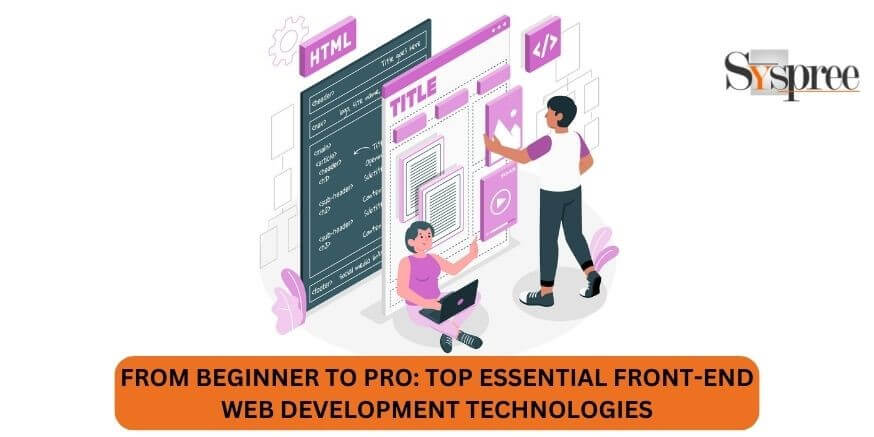We’re pleased to present our complete guide to mastering front-end web development! Whether you’re a novice newbie or a seasoned developer looking to improve your knowledge, this blog is here to help you master the most important front-end web development techniques.
The top digital marketing company believes that front-end web development plays a vital part in creating interactive and user-friendly sites. It requires the use of different technologies, including HTML, CSS, and JavaScript, to create interactive and visually appealing elements that users can view as they interact.
Let’s get started and find the best essential front-end web development techniques which will allow you to create amazing digital experiences. Learn to enhance your capabilities and realize the full potential of an experienced front-end web developer!
Key Takeaways:
- Front-end web development is creating user-facing elements of a website or web-based application using HTML, CSS, and JavaScript.
- Front-end technology enhances the user experience, increases accessibility for people who are disabled, provides compatibility with all browsers, improves performance, and drives continuous development.
- HTML creates the structure and contents of web pages. CSS handles the layout and visual presentation, and JavaScript is a way to add interactivity and dynamic functions.
- The most important front-end web development technologies comprise HTML5, CSS3, JavaScript frameworks such as React.js, Angular.js, and Vue.js flexible web designs, as well as the tools used by developers of browsers.
- Improving front-end web development capabilities requires understanding sophisticated JavaScript concepts, using components-based architectures, and understanding testing and debugging methods by using version control systems such as Git and utilizing collaboration tools and project management tools.
What is Front-End Web Development?
Front-end web development is the process of developing the elements that are visible to users of a site or web-based application. It entails designing and implementing visually appealing elements, user interaction, and the general user interface.
Front-end developers collaborate with designers to bring their ideas to reality to ensure the site or application is easy to use, responsive, and visually appealing. Get the help of a leading web development company to know about front-end web development.
Importance of Front-End Web Development Technologies
Front-end web development technology plays an essential role in creating enjoyable and user-friendly sites and apps. Here are the main arguments in favour of doing so:
-
Enhanced User Experience
Front-end technology lets developers create user interfaces that are intuitive as well as interactive user experiences. With HTML, CSS, and JavaScript, developers can develop appealing layouts and smooth animated and responsive web designs that can adapt effortlessly to various sizes of screens and devices. By focusing on user-friendly satisfaction, development on the front end can keep website visitors engaged and loyal and improves customer satisfaction and conversions.
-
Improved Accessibility
Front-end developers work to make websites accessible to people with various needs, including people with disabilities. They make sure that the site’s design and structure adhere to guidelines for accessibility to the web and make it easier for those who have auditory, visual, or motor disabilities to navigate and interact with the website’s content. Through accessible front-end methods, developers help create an inclusive online experience.
-
Performance Optimization

Performance Optimization
The top website design company in Mumbai states that front-end development techniques are crucial in optimizing website performance. By optimizing codes, compressing files and making it easier to reduce HTTP requests, as well as using caching strategies, front-end developers can increase page load speeds and the overall performance of the site.
The speed of loading is not only able to increase user satisfaction, but it can also improve results for search engine ranking since search engines favour websites that have faster loading times.
Beginning of Using Front-End Web Development
Web development for the front end is a fascinating field that lets you create innovative designs and provide immersive user experiences. In this article, we’ll explore the core technologies used in front-end development, including HTML, CSS, and JavaScript. Let’s get started!
-
Understanding HTML
HTML, a short form of Hypertext Markup Language, is the basis of each web page. It defines the structure and contents of the page, as well as defining the elements as well as their relationships. HTML utilizes tags to identify different text elements, including headings, paragraphs and images, hyperlinks and many other things.
In order to begin using HTML, it is necessary to be aware of the fundamental outline of the HTML document. It is composed of an opening tag, then followed by sections. The head section includes metadata and references to external resources, whereas the body section contains the content visible on the page.
-
Exploring CSS
CSS Cascading Style sheets are in charge of website graphic appearance and layout. It lets you set CSS styles that can be applied to HTML elements, which include colour and fonts, spacing, borders, and position. Separating styles from content layers (HTML) and CSS provides more flexibility and scalability.
For applying CSS stylesheets on HTML elements, you may use different selectors. For instance, the element selector focuses on particular HTML tags, while the class selector chooses elements according to their class names. The ID selector is a unique identifier for an element. The attribute selector can apply styles based on specific attributes.
-
Introduction to JavaScript
JavaScript is an effective scripting language that provides interactive and dynamic website features. With JavaScript, you are able to respond to user actions, alter the HTML structure, manage forms, and interact via the web server.
Essential Front-End Web Development Technologies

Front-End Web Development Technologies
As front-end web developers, keeping up-to-date with the most recent technologies and tools that increase your efficiency and enable you to deliver an impressive user experience is essential.
1. HTML5
HTML5 is the most current version of HTML, offering a range of brand enhancements and new features. It has more semantic elements. Let the best digital marketing company in Singapore guide you in detail about HTML5.
2. CSS3
CSS3 enhances its styling options CSS and adds many innovative features. It introduces new selectors like the attribute selector and pseudo-classes such as nth-child and hovers that allow for more precise control of element styling.
3. JavaScript Frameworks
JavaScript frameworks help simplify and speed up the process of creating complex web-based applications. They come with pre-built structures, libraries, and tools to speed development and provide efficient solutions to common issues. Here are three of the most popular JavaScript frameworks:
- React.js
React.js, created by Facebook, is a popular JavaScript library for building user interfaces. It uses a component-based approach that allows developers to build reusable UI components. React.js utilizes a virtual DOM (Document Object Model) model for efficient rendering. It also provides an explicit syntax for the definition of UI elements.
- Angular.js
Google maintains Angular.js, a full JavaScript framework that allows you to build dynamic web-based applications. It provides robust capabilities, such as two-way data binding, dependency injection and a modular structure. Angular.js gives developers tools to create large-scale applications with robust data handling capabilities and the ability to template.
- Vue.js
Vue.js is a scalable JavaScript framework focused on simplicity and ease of integration. It offers an intuitive and flexible structure for building user interfaces. Vue.js blends declarative rendering with reacting parts, making it simple to create interactive user interfaces. It can be incorporated in stages, allowing developers to incorporate it into existing applications seamlessly.
3. Responsive Web Design
The concept of responsive web design is a method that allows websites to adapt and offer a great user experience across a vast spectrum of screen sizes. Due to the increased use of mobile devices, responsive web design is necessary.
To create responsive design, developers use CSS media queries that apply various styles depending on the screen size of their device. They also use Fluid grid systems, flexible graphics, and responsive typography to design layouts that adjust to various screen resolutions effortlessly.
4. Browser Developer Tools
Developer tools for browsers are built-in features of web browsers that aid developers in analyzing or optimizing websites. They offer a variety of functions, such as HTML and CSS inspecting, JavaScript debugging, network monitoring, performance profiling and much more. Get the help of a brilliant digital marketing company to know more about the tools.
Popular tools for developers of browsers comprise Chrome DevTools, Firefox Developer Tools, and Safari Web Inspector. These tools are essential in diagnosing problems and testing and optimizing performance.
Taking Your Front-End Web Development Skills to the Pro Level
Web development for the front end is an ever-changing and rapidly changing field. To be a professional in this area, getting beyond the basics and digging into more advanced concepts and tools is essential.
1. Advanced JavaScript Concepts

Advanced JavaScript Concepts
JavaScript is a powerful programming language with many advanced concepts that will enhance your ability to code. The most efficient web development company shares some of the areas you should explore, including:
- OOP: Object-oriented programming (OOP) Understanding OOP principles, such as encapsulation inheritance, as well as polymorphism, allows developers to create modular, durable code.
- Asynchronous programming: Understanding the asynchronous JavaScript concepts, which include Promises async/await along with the loop, helps you manage complex tasks effectively and enhance the performance of your application.
- Functional programming: The study of functional programming methods like higher-order functions, impermanence, and pure functions increases the readability of code and allows for reuse.
2. Component-Based Architecture
Component-based architecture is a method that promotes reuse and modularization of front-end development. It is the process of breaking down an application’s web pages into smaller, self-contained parts, each accountable for a particular function or UI component.
Popular frameworks such as React.js, Angular.js, and Vue.js utilize a component-based design. With this model, it is possible to build functional and scalable applications, increase the efficiency of the organization of your code, and improve collaboration between developers.
The leading website design company in Mumbai believes that understanding the principles of a component-based architecture, including components composition, state management, and data flow, will allow you to build strong and flexible front-end software.
3. Testing and Debugging
Testing and debugging are vital capabilities for any professional front-end developer. Testing effectively ensures the integrity and quality of your source code, while effective debugging can help you find and solve problems.
Examine testing tools and libraries, such as Jest, Mocha, and Jasmine, to create Unit tests, Integration tests and tests that run through your front-end application. Learn about testing methods, including testing-driven development (TDD) or behaviour-driven design (BDD), to create reliable and bug-free software.
These tools provide a solid foundation for writing tests, but it’s also important to examine the broader overview of automation testing tools available, as they can help you automate complex workflows and streamline your development process. By incorporating tools like Functionize for end-to-end testing or Selenium for cross-browser compatibility, you can catch issues early and ensure a more stable codebase. This holistic approach to testing enhances both the quality and reliability of your front-end applications. Ultimately, mastering these tools allows you to deliver more robust and efficient software.
Refer to the screenshot below for the exact placement:
4. Version Control Systems
Version control systems (VCS) are vital tools to manage and track changes to your codebase. Git, the most well-known VCS, lets you work alongside other programmers, keep track of changes, change to earlier versions, and track branches efficiently.
The best digital marketing company in Singapore recommends learning the basic Git commands, including commit push, pull and branching operations. Learn advanced concepts such as merging, rebasing, or solving conflicts in complicated scenarios for managing version control. Platforms like GitHub and GitLab offer additional collaboration tools such as issues tracking, pull requests or code reviews.
The Importance of Web Accessibility in Front-End Web Development

Web Accessibility in Front-End Web Development
Web accessibility is an essential element of front-end web development. It requires following guidelines and applying methods and best methods to ensure that websites and apps are accessible to users with disabilities.
When they adhere to the accessibility guidelines, developers can design accessible digital experiences that are geared towards an array of users, such as those with auditory, visual cognitive, motor, or sensory impairments.
This can include considerations like the inclusion of alternative text in images or making use of the semantic HTML markup, developing using colour contrast as a consideration as well as implementing keyboard navigation and ensuring that the focus is managed properly. In focusing on accessibility on the web, developers can help create an inclusive and fair online space, allowing everyone to use and interact with digital content efficiently.
Conclusion:
The art of front-end web development requires a solid understanding of fundamental technologies such as HTML, CSS, JavaScript and frameworks such as React.js. Continuously learning and applying these tools will enable you to create stunning digital experiences. Liked this blog? Be sure to check out our previous article on Don’t Settle for Less: Discover How to Select the Perfect CMS for Your Business.








Great Post! I learned a lot about web development technologies from reading this. Thanks for sharing.
Glad to know you found the blog informative
Informative post. Thank you for sharing the post.